*NURSING > Summary > Medical-Surgical Nursing: Med Surg Exam: All Question and Answers and the Rationale. (All)
Medical-Surgical Nursing: Med Surg Exam: All Question and Answers and the Rationale.
Document Content and Description Below
Med Surg Exam: All Question and Answers A nurse is collecting data regarding a client after a thyroidectomy and notes that the client has developed hoarseness and a weak voice. Which nursing action i... s appropriate? 1. Check for signs of bleeding. 2. Administer calcium gluconate. 3. Notify the registered nurse immediately. 4. Reassure the client that this is usually a temporary condition. A nurse is assisting with preparing a teaching plan for the client with diabetes mellitus regarding proper foot care. Which instruction should be included in the plan of care? 1. Soak the feet in hot water. 2. Avoid using soap to wash the feet. 3. Apply a moisturizing lotion to dry feet, but not between the toes. 4. Always have a podiatrist cut your toenails; never cut them yourself. A nurse provides dietary instructions to a client with diabetes mellitus regarding the prescribed diabetic diet. Which statement, if made by the client, indicates the need for further teaching? 1. "I'll eat a balanced meal plan." 2. "I need to drink diet soft drinks." 3. "I need to buy special dietetic foods." 4. "I will snack on fruit instead of cake." A nurse reinforces teaching with a client with diabetes mellitus regarding differentiating between hypoglycemia and ketoacidosis. The client demonstrates an understanding of the teaching by stating that glucose will be taken if which symptom develops? 1. Polyuria 2. Shakiness 3. Blurred vision 4. Fruity breath odor When the nurse is teaching a client who has been newly diagnosed with type 1 diabetes mellitus, which statement by the client would indicate that teaching has been effective? 1. "I will stop taking my insulin if I'm too sick to eat." 2. "I will decrease my insulin dose during times of illness." 3. "I will adjust my insulin dose according to the level of glucose in my urine." 4. "I will notify my health care provider if my blood glucose level is greater than 250 mg/dL." A nurse is monitoring a client who has been newly diagnosed with diabetes mellitus for signs of complications. Which of the following, if exhibited by the client, would indicate hyperglycemia and thus warrant health care provider notification? 1. Polyuria 2. Bradycardia 3. Diaphoresis 4. Hypertension A nurse is reinforcing instructions with a client with diabetes mellitus who is recovering from diabetic ketoacidosis (DKA) regarding measures to prevent a recurrence. Which instruction is important for the nurse to emphasize? 1. Eat six small meals daily. 2. Test the urine ketone levels. 3. Monitor blood glucose levels frequently. 4. Receive appropriate follow-up health care. A nurse is reviewing discharge teaching with a client who has Cushing's syndrome. Which statement by the client indicates that the instructions related to dietary management were understood? 1. "I can eat foods that contain potassium." 2. "I will need to limit the amount of protein in my diet." 3. "I am fortunate that I can eat all the salty foods I enjoy." 4. "I am fortunate that I do not need to follow any special diet." A client with type 1 diabetes mellitus calls the nurse to report recurrent episodes of hypoglycemia. Which statement by the client indicates a correct understanding of NPH insulin and exercise? 1. "I should not exercise after lunch." 2. "I should not exercise after breakfast." 3. "I should not exercise in the late evening." 4. "I should not exercise in the late afternoon." A nurse is caring for a postoperative parathyroidectomy client. Which of the following would require the nurse's immediate attention? 1. Incisional pain 2. Laryngeal stridor 3. Difficulty voiding 4. Abdominal cramps When a nurse notes that a client with type 1 diabetes mellitus has lipodystrophy on both upper thighs, what information should the nurse obtain from the client? 1. Plan of injection rotation 2. Consistency of aspiration 3. Preparation of the injection site 4. Angle at which the medication is administered A nurse is monitoring a client receiving glipizide (Glucotrol). Which outcome indicates an ineffective response from the medication? 1. A decrease in polyuria 2. A decrease in polyphagia 3. A fasting plasma glucose of 100 mg/dL 4. A glycosylated hemoglobin level of 12% A nurse assists in developing a plan of care for a client with hyperparathyroidism receiving calcitonin-human (Cibacalcin). Which outcome has the highest priority regarding this medication? 1. Relief of pain 2. Absence of side effects 3. Reaching normal serum calcium levels 4. Verbalization of appropriate medication knowledge A nursing instructor asks a student to describe the pathophysiology that occurs in Cushing's disease. Which statement by the student indicates an accurate understanding of this disorder? 1. "Cushing's disease is characterized by an oversecretion of insulin." 2. "Cushing's disease is characterized by an oversecretion of glucocorticoid hormones." 3. "Cushing's disease is characterized by an undersecretion of corticotropic hormones." 4. "Cushing's disease is characterized by an undersecretion of glucocorticoid hormones." A client with type 1 diabetes mellitus is to begin an exercise program, and the nurse is providing instructions to the client regarding the program. Which of the following should the nurse include in the teaching plan? 1. Try to exercise before mealtime. 2. Administer insulin after exercising. 3. Take a blood glucose test before exercising. 4. Exercise should be performed during peak times of insulin. A nurse would expect to note which interventions in the plan of care for a client with hypothyroidism? Select all that apply. 1. Provide a cool environment for the client. 2. Instruct the client to consume a high-fat diet. 3. Instruct the client about thyroid replacement therapy. 4. Encourage the client to consume fluids and high-fiber foods in the diet. 5. Instruct the client to contact the health care provider if episodes of chest pain occur. 6. Inform the client that iodine preparations will be prescribed to treat the disorder. Which client complaint would alert the nurse to a possible hypoglycemic reaction? 1. Tremors 2. Anorexia 3. Hot, dry skin 4. Muscle cramps Which nursing action would be appropriate to implement when a client has a diagnosis of pheochromocytoma? 1. Weigh the client. 2. Test the client's urine for glucose. 3. Monitor the client's blood pressure. 4. Palpate the client's skin to determine warmth. A nurse is caring for a client with pheochromocytoma. The client is scheduled for an adrenalectomy. During the preoperative period, the priority nursing action would be to monitor the: 1. Vital signs 2. Intake and output 3. Blood urea nitrogen (BUN) level 4. Urine for glucose and acetone A nurse is caring for a client with pheochromocytoma. The client asks for a snack and something warm to drink. The appropriate choice for this client to meet nutritional needs would be which of the following? 1. Crackers with cheese and tea 2. Graham crackers and warm milk 3. Toast with peanut butter and cocoa 4. Vanilla wafers and coffee with cream and sugar A nurse is caring for a client with pheochromocytoma. Which data would indicate a potential complication associated with this disorder? 1. A urinary output of 50 mL/hr 2. A coagulation time of 5 minutes 3. Congestion heard on auscultation of the lungs 4. A blood urea nitrogen (BUN) level of 20 mg/dL A nurse is caring for a client after thyroidectomy and monitoring for signs of thyroid storm. The nurse understands that which of the following is a manifestation associated with this disorder? 1. Bradycardia 2. Hypotension 3. Constipation 4. Hypothermia When caring for a client who is having clear drainage from his nares after transsphenoidal hypophysectomy, which action by the nurse is appropriate? 1. Lower the head of the bed. 2. Test the drainage for glucose. 3. Obtain a culture of the drainage. 4. Continue to observe the drainage. After several diagnostic tests, a client is diagnosed with diabetes insipidus. The nurse understands that which symptom is indicative of this disorder? 1. Diarrhea 2. Polydipsia 3. Weight gain 4. Blurred vision Which clinical manifestation should the nurse expect to note when assessing a client with Addison's disease? 1. Edema 2. Obesity 3. Hirsutism 4. Hypotension What would the nurse anticipate being included in the plan of care for a client who has been diagnosed with Graves' disease? 1. Provide a high-fiber diet. 2. Provide a restful environment. 3. Provide three small meals per day. 4. Provide the client with extra blankets. A licensed practical nurse (LPN) is assisting a high school nurse in conducting a session with female adolescents regarding the menstrual cycle. The LPN tells the adolescents that the normal duration of the menstrual cycle is about: 1. 14 days 2. 28 days 3. 30 days 4. 45 days A maternity nursing instructor asks a nursing student to identify the hormones that are produced by the ovaries. Which of the following, if identified by the student, indicates an understanding of the hormones produced by this endocrine gland? 1. Oxytocin 2. Luteinizing hormone (LH) 3. Estrogen and progesterone 4. Follicle-stimulating hormone (FSH) Which statement by the client would cause the nurse to suspect that the thyroid test results drawn on the client this morning may be inaccurate? 1. "I had a radionuclide test done 3 days ago." 2. "When I exercise I sweat more than normal." 3. "I drank some water before the blood was drawn." 4. "That hamburger I ate before the test sure tasted good." A nurse is preparing to provide instructions to a client with Addison's disease regarding diet therapy. The nurse understands that which of the following diets would likely be prescribed for this client? 1. Low-protein diet 2. Low-sodium diet 3. High-sodium diet 4. Low-carbohydrate diet Which of the following statements made by the nursing student demonstrates an understanding of the hormone oxytocin? 1. "Production of oxytocin occurs in the ovaries." 2. "It is produced by the anterior pituitary gland." 3. "It causes contractions of the uterus during birth." 4. "Release of oxytocin stimulates the pancreas to produce insulin." A nurse is caring for a client with a diagnosis of hypoparathyroidism. The nurse reviews the laboratory results drawn on the client and notes that the calcium level is extremely low. The nurse would expect to note which of the following on data collection of the client? 1. Positive Trousseau's sign 2. Negative Chvostek's sign 3. Unresponsive pupils 4. Hyperactive bowel sounds A nurse is providing instructions to a client newly diagnosed with diabetes mellitus. The nurse gives the client a list of the signs of hyperglycemia. Which of the following specific signs of this complication should be included on the list? 1. Decreased urine output 2. Profuse sweating 3. Increased thirst 4. Shakiness A nurse enters the room of a client with type 1 diabetes mellitus and finds the client difficult to arouse. The client's skin is warm and flushed, and the pulse and respiratory rate are elevated from the client's baseline. The nurse would immediately: 1. Prepare for the administration of an insulin drip. 2. Give the client a glass of orange juice. 3. Prepare for the administration of a bolus dose of 50% dextrose. 4. Check the client's capillary blood glucose. A client with diabetes mellitus calls the clinic nurse to report that the blood glucose level is 150 mg/dL. After obtaining further data from the client, the nurse determines that the client ate lunch approximately 2 hours ago. The nurse would interpret these results to be: 1. Normal 2. Lower than the normal value 3. Slightly higher than the normal value 4. A value that indicates immediate health care provider notification A client with type 1 diabetes mellitus takes NPH insulin every morning and checks the blood glucose level four times per day. The client tells the nurse that yesterday the late afternoon blood glucose was 60 mg/dL and that she "felt funny." Which statement by the client would indicate an understanding of this occurrence? 1. "My blood glucose levels are running low because I'm tired." 2. "I forgot to take my usual afternoon snack yesterday." 3. "I took less insulin this morning so I won't feel funny today." 4. "I don't know why I have to check my blood glucose four times a day. That seems too much." A nurse caring for a client scheduled for a transsphenoidal hypophysectomy to remove a tumor in the pituitary gland assists to develop a plan of care for the client. The nurse suggests including which specific information in the preoperative teaching plan? 1. Hair will need to be shaved. 2. Deep breathing and coughing will be needed after surgery. 3. Toothbrushing will not be permitted for at least 2 weeks following surgery. 4. Spinal anesthesia is used. Following hypophysectomy, a client complains of being very thirsty and having to urinate frequently. The initial nursing action is to: 1. Document the complaints. 2. Increase fluid intake. 3. Check the urine specific gravity. 4. Check for urinary glucose. A client is brought to the emergency department in an unresponsive state, and a diagnosis of hyperglycemic hyperosmolar nonketotic syndrome (HHNS) is made. The nurse who is assisting to care for the client obtains which of the following immediately in preparation for the treatment of this syndrome? 1. NPH insulin 2. A nasal cannula 3. Intravenous (IV) infusion of sodium bicarbonate 4. IV infusion of normal saline A client with a diagnosis of diabetic ketoacidosis (DKA) is being treated in the emergency department. Which of the following findings would the nurse expect to note as confirming this diagnosis? 1. Elevated blood glucose and low plasma bicarbonate 2. Decreased urine output 3. Increased respirations and an increase in pH 4. Coma A client is admitted to the hospital with a diagnosis of diabetic ketoacidosis (DKA). The initial serum glucose level was 950 mg/dL. Intravenous (IV) insulin was started along with rehydration with IV normal saline. The serum glucose level is now 240 mg/dL. The nurse who is assisting in caring for the client obtains which of the following items, anticipating a health care provider's prescription? 1. IV infusion containing 5% dextrose 2. NPH insulin and a syringe for subcutaneous injection 3. An ampule of 50% dextrose 4. Phenytoin (Dilantin) for prevention of seizures A client with diabetes mellitus is being discharged following treatment for hyperglycemic hyperosmolar nonketotic syndrome (HHNS) precipitated by acute illness. The client states to the nurse, "I will call the doctor next time I can't eat for more than a day or so." The nurse plans care, understanding that which of the following accurately reflects this client's level of knowledge? 1. The client needs immediate education before discharge. 2. The client's statement is accurate, but knowledge should be evaluated further. 3. The client's statement is inaccurate, and the client should be scheduled for outpatient diabetic counseling. 4. The client requires follow-up teaching regarding the administration of insulin. A health care provider has prescribed propylthiouracil (PTU) for a client with hyperthyroidism, and the nurse assists in developing a plan of care for the client. A priority nursing measure to be included in the plan regarding this medication is to monitor the client for: 1. Signs and symptoms of hypothyroidism 2. Signs and symptoms of hyperglycemia 3. Relief of pain 4. Signs of renal toxicity A nurse is assisting in preparing a care plan for a client with diabetes mellitus who has hyperglycemia. The nurse focuses on which potential problem for this client? 1. Dehydration 2. The need for knowledge about the causes of hyperglycemia 3. Lack of knowledge about nutrition 4. Inability of family to cope with the client's diagnosis A nurse is assigned to care for a client at home who has a diagnosis of type 1 diabetes mellitus. When the nurse arrives to care for the client, the client tells the nurse that she has been vomiting and has diarrhea. Which additional statement by the client indicates a need for further teaching? 1. "I need to stop my insulin." 2. "I need to increase my fluid intake." 3. "I need to call my health care provider." 4. "I need to monitor my blood glucose every 4 to 6 hours." A nurse is assigned to assist in caring for a client admitted to the emergency department with diabetic ketoacidosis (DKA). In the acute phase, the priority nursing action is to plan to prepare to: 1. Administer intravenous (IV) regular insulin. 2. Administer IV 5% dextrose. 3. Correct the acidosis. 4. Apply an electrocardiogram (ECG) monitor. A client with type 2 diabetes mellitus has a blood glucose of more than 600 mg/dL and is complaining of polydipsia, polyuria, weight loss, and weakness. The nurse reviews the health care provider's documentation and would expect to note which of the following diagnoses? 1. Diabetic ketoacidosis (DKA) 2. Hypoglycemia 3. Hyperglycemic hyperosmolar nonketotic syndrome (HHNS) 4. Pheochromocytoma A nurse is preparing to administer an injection of regular insulin. The vial of the regular insulin has been refrigerated. On inspection of the vial, the nurse finds that the medication is frozen. The nurse should: 1. Wait for the insulin to thaw at room temperature. 2. Check the temperature settings of the refrigerator. 3. Discard the insulin and obtain another vial. 4. Rotate the vial between the hands until the medication becomes liquid. A nurse has collected data on a client with diabetes mellitus. Findings include a fasting blood glucose of 130 mg/dL, temperature 101° F, pulse of 88 beats per minute, respirations of 22 breaths per minute, and a blood pressure of 118/78 mm Hg. Which finding would be of concern to the nurse? 1. Pulse and respirations 2. Blood pressure 3. Blood glucose 4. Temperature A nurse is collecting data from a client newly diagnosed with diabetes mellitus regarding the client's learning readiness. Which client behavior indicates to the nurse that the client is not ready to learn? 1. The client complains of fatigue whenever the nurse plans a teaching session. 2. The client asks if the spouse can attend the classes also. 3. The client asks for written materials about diabetes before class. 4. The client asks appropriate questions about what will be taught. A client with diabetes mellitus visits the health care clinic. The client previously had been well controlled with glyburide (Diabeta), but recently, the fasting blood glucose has been running 180 to 200 mg/dL. Which of the following medications, if added to the client's regimen, may be contributing to the hyperglycemia? 1. Prednisone 2. Atenolol (Tenormin) 3. Phenelzine (Nardil) 4. Allopurinol (Zyloprim) A health care provider prescribes a 24-hour urine collection for vanillylmandelic acid (VMA). The nurse instructs the client in the procedure for the collection of the urine. Which statement by the client would indicate a need for further instruction? 1. "I will start the collection in 2 days. I cannot eat or drink any tea, chocolate, vanilla, or fruit until the test is completed." 2. "When I start the collection, I will urinate and discard that specimen." 3. "I will pour the urine into the collection bottle each time I urinate and refrigerate the urine." 4. "I can take any medications if I need to before the collection." A nurse in an outpatient diabetes clinic is assisting in caring for a client on insulin pump therapy. Which statement by the client indicates that a knowledge deficit exists regarding insulin pump therapy? 1. "If my blood sugars are elevated, I can bolus myself with additional insulin as prescribed." 2. "I'll need to check my blood sugars before meals in case I need a pre-meal insulin bolus." 3. "Now that I have this pump, I don't have to worry about insulin reactions or ketoacidosis occurring again." 4. "I still need to follow an appropriate diet and exercise plan even though I don't have to inject myself daily anymore." A client with Graves' disease has exophthalmos and is experiencing photophobia. Which intervention would best assist the client with this problem? 1. Administering methimazole (Tapazole) every 8 hours 2. Lubricating the eyes with tap water every 2 to 4 hours 3. Instructing the client to avoid straining or heavy lifting 4. Obtaining dark glasses for the client The nurse caring for a client who has had a subtotal thyroidectomy reviews the plan of care and determines which problem is the priority for this client in the immediate postoperative period? 1. Dehydration 2. Infection 3. Urinary retention 4. Bleeding A comatose client with an admitting diagnosis of diabetic ketoacidosis (DKA) has a blood glucose of 368 mg/dL, arterial pH of 7.2, arterial bicarbonate of 14 mEq/L, and a positive for serum ketones. The diagnosis is supported by which noted data? 1. Hypertension 2. Fruity breath odor 3. Slow regular breathing 4. Moist mucous membranes A nurse is collecting data on a client admitted to the hospital with a diagnosis of myxedema. Which data collection technique will provide data necessary to support the admitting diagnosis? 1. Auscultation of lung sounds 2. Inspection of facial features 3. Percussion of the thyroid gland 4. Palpation of the adrenal glands A client with Cushing's disease is being admitted to the hospital after a stab wound to the abdomen. The nurse plans care and places highest priority on which potential problem? 1. Nervousness 2. Infection 3. Concern about appearance 4. Inability to care for self A nurse has reinforced instructions about measuring blood glucose levels to a client newly diagnosed with diabetes mellitus. The nurse determines that the client understands the procedure when making which most accurate statement? 1. "I should check my blood glucose level before eating a big meal." 2. "I should check my blood glucose level before eating each meal, regardless of how much I eat." 3. "I should check my blood glucose level 2 hours after each meal." 4. "I should check my blood glucose level once a day." A nurse is reinforcing dietary instructions to a client newly diagnosed with diabetes mellitus. The nurse instructs the client that it is best to: 1. Eat meals at approximately the same time each day. 2. Adjust mealtimes depending on blood glucose levels. 3. Vary mealtimes if insulin is not administered at the same time every day. 4. Avoid being concerned about the time of meals as long as snacks are taken on time. A client with diabetes mellitus who takes insulin is seen in the health care clinic. The client tells the nurse that after giving the injection, the insulin seems to leak through the skin. The nurse can appropriately determine the problem by asking the client which of the following? 1. "Are you placing an air bubble in the syringe before injection?" 2. "Are you using a 1-inch needle to give the injection?" 3. "Are you aspirating before you inject the insulin?" 4. "Are you rotating the injection site?" A nurse is reinforcing instructions to a client newly diagnosed with diabetes mellitus regarding insulin administration. The health care provider has prescribed a mixture of NPH and regular insulin. The nurse should stress that the first step is to: 1. Inject air equal to the amount of regular insulin prescribed into the vial of regular insulin. 2. Inject air equal to the amount of NPH insulin prescribed into the vial of NPH insulin. 3. Draw up the correct dosage of regular insulin into the syringe. 4. Draw up the correct dosage of NPH insulin into the syringe. A nurse is reviewing the prescriptions of a client diagnosed with diabetes mellitus who was admitted because of an infected foot ulcer. Which health care provider's prescription supports the treatment of this condition? 1. A decreased amount of NPH daily insulin 2. An increased amount of NPH daily insulin 3. An increased-calorie diet 4. A decreased-calorie diet 1. Slow pulse; lethargy; and warm, dry skin 2. Elevated pulse; lethargy; and warm, dry skin 3. Elevated pulse; shakiness; and cool, clammy skin 4. Slow pulse, confusion, and increased urine output A nurse notes in the medical record that a client with Cushing's syndrome is experiencing fluid overload. Which interventions should be included in the plan of care? Select all that apply. 1. Monitoring daily weight 2. Monitoring intake and output 3. Maintaining a low-potassium diet 4. Monitoring extremities for edema 5. Maintaining a low-sodium diet A nursing student notes in the medical record that a client with Cushing's syndrome is experiencing body image disturbances. The need for additional education regarding this problem is identified when the nursing student suggests which nursing intervention? 1. Encouraging the client's expression of feelings 2. Evaluating the client's understanding of the disease process 3. Encouraging family members to share their feelings about the disease process 4. Evaluating the client's understanding that the body changes need to be dealt with A nurse is caring for a client following an adrenalectomy and is monitoring for signs of adrenal insufficiency. Which of the following, if noted in the client, indicates signs and symptoms related to adrenal insufficiency? Select all that apply. 1. Double vision 2. Hypotension 3. Mental status changes 4. Weakness 5. Fever A nurse is reinforcing home care instructions to a client with a diagnosis of Cushing's syndrome. Which statement reflects a need for further client education? 1. "Taking my medications exactly as prescribed is essential." 2. "I need to read the labels on any over-the-counter medications I purchase." 3. "My family needs to be familiar with the signs and symptoms of hypoadrenalism." 4. "I could experience the signs and symptoms of hyperadrenalism because of Cushing's." A nurse is reviewing a plan of care for a client with Addison's disease. The nurse notes that the client is at risk for dehydration and suggests nursing interventions that will prevent this occurrence. Which nursing intervention is an appropriate component of the plan of care? Select all that apply. 1. Encouraging fluid intake of at least 3000 mL/day 2. Encouraging an intake of low-protein foods 3. Monitoring for changes in mental status 4. Monitoring intake and output 5. Maintaining a low-sodium diet A nurse is reviewing the postoperative prescriptions for a client who had a transsphenoidal hypophysectomy. Which health care provider's prescription, if noted on the record, indicates the need for clarification? 1. Instruct the client about the need for a Medic-Alert bracelet. 2. Apply a loose dressing if any clear drainage is noted. 3. Monitor vital signs and neurological status. 4. Instruct the client to avoid blowing the nose. A nurse reviews a plan of care for a postoperative client following a thyroidectomy and notes that the client is at risk for breathing difficulty. Which of the following nursing interventions will the nurse suggest to include in the plan of care? 1. Maintain a supine position. 2. Encourage coughing and deep breathing exercises. 3. Monitor neck circumference frequently. 4. Maintain a pressure dressing on the operative site. A nurse is monitoring a client following a thyroidectomy for signs of hypocalcemia. Which of the following signs, if noted in the client, likely indicates the presence of hypocalcemia? 1. Tingling around the mouth 2. Negative Chvostek's sign 3. Flaccid paralysis 4. Bradycardia A nurse is caring for a client following a thyroidectomy. The client tells the nurse that she is concerned because of voice hoarseness. The client asks the nurse whether the hoarseness will subside. The nurse appropriately tells the client that the hoarseness: 1. Indicates nerve damage 2. Is harmless but permanent 3. Will worsen before it subsides 4. Is normal and will gradually subside A nurse is monitoring a client with Graves' disease for signs of thyrotoxic crisis (thyroid storm). Which of the following signs and symptoms, if noted in the client, will alert the nurse to the presence of this crisis? Select all that apply. 1. Bradycardia 2. Fever 3. Sweating 4. Agitation 5. Pallor Which of the following clients is at risk for developing thyrotoxicosis? 1. A client with hypothyroidism 2. A client with Graves' disease who is having surgery 3. A client with diabetes mellitus scheduled for debridement of a foot ulcer 4. A client with diabetes insipidus scheduled for an invasive diagnostic test A nurse is caring for a client diagnosed with hyperparathyroidism who is prescribed furosemide (Lasix). The nurse reinforces dietary instructions to the client. Which of the following is an appropriate instruction? 1. Increase dietary intake of calcium. 2. Drink at least 2 to 3 L of fluid daily. 3. Eat sparely when experiencing nausea. 4. Decrease dietary intake of potassium. A nurse has reinforced instructions to the client with hyperparathyroidism regarding home care measures related to exercise. Which statement by the client indicates a need for further instruction? Select all that apply. 1. "I enjoy exercising but I need to be careful." 2. "I need to pace my activities throughout the day." 3. "I need to limit playing football to only the weekends." 4. "I should gauge my activity level by my energy level." 5. "I should exercise in the evening to encourage a good sleep pattern." A nurse has reinforced dietary instructions to a client with a diagnosis of hypoparathyroidism. The nurse instructs the client to include which of the following items in the diet? 1. Vegetables 2. Meat 3. Fish 4. Cereals A nurse has reinforced home care measures to a client diagnosed with diabetes mellitus regarding exercise and insulin administration. Which statement by the client indicates a need for further instruction? 1. "I should perform my exercise at peak insulin time." 2. "I should always carry a quick-acting carbohydrate when I exercise." 3. "I should always wear a Medic-Alert bracelet especially when I exercise." 4. "I should avoid exercising at times when a hypoglycemic reaction is likely to occur." A nurse is caring for a client newly diagnosed with diabetes mellitus. The client asks the nurse whether eating at a restaurant will affect the diabetic control and whether this is allowed. Which nursing response is appropriate? 1. "You really should not eat in restaurants." 2. "If you plan to eat in a restaurant, you need to avoid carbohydrates." 3. "You should order a half-portion meal and have fresh fruit for dessert." 4. "You should increase your daily dose of insulin by half on the day you plan to eat out." A client who is managing diabetes mellitus with insulin injections asks the nurse for information about any necessary changes in her diet to avoid hyperinsulinism. Which of the following diets would be appropriate for the client? 1. Low-fiber, high-fat diet 2. Limit carbohydrate intake to three meals per day 3. Large amounts of carbohydrates between low protein meals 4. Small frequent meals with protein, fat, and carbohydrates at each meal A client has an endocrine system dysfunction of the pancreas. The nurse anticipates that the client will exhibit impaired secretion of which of the following substances? 1. Amylase 2. Lipase 3. Trypsin 4. Insulin An adult client just admitted to the hospital with heart failure also has a history of diabetes mellitus. The nurse calls the health care provider to verify a prescription for which medication that the client was taking before admission? 1. NPH insulin 2. Regular insulin 3. Acarbose (Precose) 4. Chlorpropamide A nurse is providing discharge instructions to a client who had a unilateral adrenalectomy. Which of the following will be a component of the instructions? 1. The reason for maintaining a diabetic diet 2. Instructions about early signs of a wound infection 3. Teaching regarding proper application of an ostomy pouch 4. The need for lifelong replacement of all adrenal hormones A nurse is caring for a client experiencing thyroid storm. Which of the following would be a priority concern for this client? 1. Inability to cope with the treatment plan 2. Lack of sexual drive 3. Self-consciousness about body appearance 4. Potential for cardiac disturbances A nurse is collecting data on a client with hyperparathyroidism. Which of the following questions would elicit the accurate information about this condition from the client? 1. "Do you have tremors in your hands?" 2. "Are you experiencing pain in your joints?" 3. "Have you had problems with diarrhea lately?" 4. "Do you notice swelling in your legs at night?" A client is in metabolic acidosis caused by diabetic ketoacidosis (DKA). The nurse prepares for the administration of which of the following medications as a primary treatment for this problem? 1. Potassium 2. Regular insulin 3. Sodium bicarbonate 4. Calcium gluconate A nurse is caring for a postoperative adrenalectomy client. Which of the following does the nurse specifically monitor for in this client? 1. Peripheral edema 2. Bilateral exophthalmos 3. Signs and symptoms of hypocalcemia 4. Signs and symptoms of hypovolemia A nurse is caring for a client with a diagnosis of myasthenia gravis. The health care provider plans to perform an Enlon test on the client to determine the presence of cholinergic crisis. In addition to planning care for the client during this testing, which of the following will the nurse ensure is at the bedside? 1. Cardiac monitor 2. Oxygen equipment 3. Vial of protamine sulfate and a syringe 4. Potassium injection and a liter of normal saline solution A client with myxedema has changes in intellectual function such as impaired memory, decreased attention span, and lethargy. The client's husband is upset and shares his concerns with the nurse. Which statement by the nurse is helpful to the client's husband? 1. "Would you like me to ask the health care provider for a prescription for a stimulant?" 2. "Give it time. I've seen dozens of clients with this problem that fully recover." 3. "I don't blame you for being frustrated, because the symptoms will only get worse." 4. "It's obvious that you are concerned about your wife's condition, but the symptoms may improve with continued therapy." A client with hypoparathyroidism has hypocalcemia. The nurse avoids giving the client the prescribed vitamin and calcium supplement with which of the following liquids? 1. Milk 2. Water 3. Iced tea 4. Fruit juice A client is diagnosed with hyperparathyroidism. The nurse teaching the client about dietary alterations to manage the disorder tells the client to limit which of the following foods in the diet? 1. Bananas 2. Oatmeal 3. Ice cream 4. Chicken breast A nurse participating in a free health screening at the local mall obtains a random blood glucose level of 200 mg/dL on an otherwise healthy client. The nurse tells the client to do which of the following as a next step? 1. Seek treatment for diabetes mellitus. 2. Ask the pharmacist about starting insulin therapy. 3. Begin blood glucose monitoring three times a day. 4. Call the health care provider to have the value rechecked as soon as possible.. A client with Addison's disease asks the nurse how a newly prescribed medication, fludrocortisone acetate (Florinef), will improve the condition. When formulating a response, the nurse should incorporate that a key action of this medication is to: 1. Help restore electrolyte balance. 2. Make the body produce more cortisol. 3. Replace insufficient circulating estrogens. 4. Alter the body's immune system functioning. A nurse reviews the nursing care plan of an older client with diabetic neuropathy of the lower extremities as a result of type 2 diabetes mellitus. The nurse plans care, knowing that which problem has the highest priority for this client? 1. Pain as a result of intermittent claudication 2. Lack of self-confidence as a result of impaired ability to walk 3. Lack of self-esteem as a result of perceived loss of abilities 4. The possibility of injury as a result of decreased sensation in the legs and feet An older client with a history of hyperparathyroidism and severe osteoporosis is hospitalized. The nurse caring for the client plans first to address which problem? 1. The possibility of injury 2. Constipation 3. Urinary retention 4. Need for teaching about the disorder A client has been diagnosed with hypoparathyroidism. The nurse teaches the client to include foods in the diet that are: 1. High in phosphorus and low in calcium 2. Low in phosphorus and low in calcium 3. Low in phosphorus and high in calcium 4. High in phosphorus and high in calcium A hospitalized client is newly diagnosed with diabetes mellitus. The client must take both NPH and Regular insulin for glucose control. The nurse develops a teaching plan to help the client meet which outcome as a first step in managing the disease? 1. Avoid all strenuous exercise. 2. Maintain health at an optimum level. 3. Lose 40 pounds to achieve ideal body weight. 4. Adjust insulin according to capillary blood glucose levels. A client newly diagnosed with diabetes mellitus takes NPH insulin every day at 7:00 ᴀᴍ. The nurse has taught the client how to recognize the signs of hypoglycemia. The nurse determines that the client understands the information presented if the client watches for which of the following signs in the late afternoon? 1. Nausea and vomiting, and abdominal pain 2. Hunger; shakiness; and cool, clammy skin 3. Drowsiness; red, dry skin; and fruity breath odor 4. Increased urination; thirst; and rapid, deep breathing A client newly diagnosed with diabetes mellitus is having difficulty learning the technique of blood glucose measurement. The nurse should teach the client to do which of the following to perform the procedure properly? 1. Wash the hands first using cold water. 2. Puncture the center of the finger pad. 3. Puncture the finger as deeply as possible. 4. Let the arm hang dependently and milk the digit. A nurse is planning to instruct a client with diabetes mellitus who has hypertension about "sick day management." Which of the following does the nurse avoid putting on a list of easily consumed carbohydrate-containing beverages for use when the client cannot tolerate food orally? 1. Cola 2. Ginger ale 3. Apple juice 4. Mineral water A nurse is monitoring the results of periodic serum laboratory studies drawn on a client with diabetic ketoacidosis (DKA) receiving an insulin infusion. The nurse determines that which of the following values needs to be reported? 1. Potassium 3.1 mEq/L 2. Calcium 9.2 mg/dL 3. Sodium 137 mEq/L 4. Serum osmolality 288 mOsm/kg H2O The wife of a client with diabetes mellitus who takes insulin calls the nurse in a health care provider's office about her husband. She states that her husband is sleepy and that his skin is warm and flushed. She adds that his breathing is faster than normal and his pulse rate seems fast. Which of the following should the nurse tell the woman to do first? 1. Call an ambulance. 2. Take his temperature. 3. Check his blood glucose level. 4. Drive him to the health care provider's office. A male client recently diagnosed with diabetes mellitus requiring insulin tells the clinic nurse that he is traveling by air throughout the next week. The client asks the nurse for any suggestions about managing the disorder while traveling. The nurse tells the client to: 1. Obtain referrals to health care providers in the destination cities. 2. Check the blood glucose every 2 hours during the flight. 3. Keep snacks in carry-on luggage to prevent hypoglycemia during the flight. 4. Pad the insulin and syringes against breakage and place in a suitcase to be stowed. A client scheduled for a thyroidectomy says to the nurse, "I am so scared to get cut in my neck." Based on the client's statement, the nurse determines that the client is experiencing which problem? 1. Inadequate knowledge about the surgical procedure 2. Fear about impending surgery 3. Embarrassment about the changes in personal appearance 4. Lack of support related to the surgical procedure A nurse is caring for a client with Addison's disease. The nurse checks the vital signs and determines that the client has orthostatic hypotension. The nurse determines that this finding relates to which of the following? 1. A decrease in cortisol release 2. A decreased secretion of aldosterone 3. An increase in epinephrine secretion 4. Increased levels of androgens 1. Restricting fluid intake 2. Offering foods high in potassium 3. Checking family support systems 4. Monitoring the blood glucose A nurse is collecting data on a client with a diagnosis of hypothyroidism. Which of these behaviors, if present in the client's history, would the nurse determine as being likely related to the manifestations of this disorder? 1. Depression 2. Nervousness 3. Irritability 4. Anxiety While collecting data on a client being prepared for an adrenalectomy, the nurse obtains a temperature reading of 100.8° F. The nurse analyzes this temperature reading as: 1. Within normal limits 2. A finding that needs to be reported immediately 3. An expected finding caused by the operative stress response 4. Slightly abnormal but an insignificant finding The anticipated intended effect of fludrocortisone acetate (Florinef) for the treatment of Addison's disease is to: 1. Stimulate the immune response. 2. Promote electrolyte balance. 3. Stimulate thyroid production. 4. Stimulate thyrotropin production. A nurse is caring for a client with hypothyroidism who is overweight. Which food items would the nurse suggest to include in the plan? 1. Peanut butter, avocado, and red meat 2. Skim milk, apples, whole-grain bread, and cereal 3. Organ meat, carrots, and skim milk 4. Seafood, spinach, and cream cheese A client has a blood glucose level drawn for suspected hyperglycemia. After interviewing the client, the nurse determines that the client ate lunch approximately 2 hours before the blood specimen was drawn. The laboratory reports that the blood glucose to be 180 mg/dL, and the nurse analyzes this result to be: 1. Normal 2. Lower than the normal value 3. Elevated from the normal value 4. A dangerously high value requiring immediate health care provider notification In planning nutrition for the client with hypoparathyroidism, which diet would be appropriate? 1. High in calcium and low phosphorous 2. Low in vitamins A, D, E, and K 3. High in sodium with no fluid restriction 4. Low in water and insoluble fiber A nurse is caring for a client with type 1 diabetes mellitus who is hyperglycemic. Which problem would the nurse consider first, when planning care for this client? 1. The need for knowledge about the diagnosis 2. Insomnia 3. Lack of appetite 4. Signs of dehydration A preoperative client is scheduled for adrenalectomy to remove a pheochromocytoma. The nurse would most closely monitor which of the following items in the preoperative period? 1. Intake and output 2. Blood urea nitrogen (BUN) 3. Vital signs 4. Urine glucose and ketones A nurse working on an endocrine nursing unit understands that which correct concept is used in planning care? 1. Clients with Cushing's syndrome are likely to experience episodic hypotension. 2. Clients with hyperthyroidism must be monitored for weight gain. 3. Clients who have diabetes insipidus should be assessed for fluid excess. 4. Clients who have hyperparathyroidism should be protected against falls. Glucagon hydrochloride injection would most likely be prescribed for which disorder? 1. Thyroid crisis 2. Type 1 diabetes mellitus 3. Hypoadrenalism 4. Excess growth hormone secretion When caring for a client diagnosed with pheochromocytoma, what information should the nurse know when assisting with planning care? 1. Profound hypotension may occur. 2. Excessive catecholamines are released. 3. The condition is not curable and is treated symptomatically. 4. Hypoglycemia is the primary presenting symptom. A client with pheochromocytoma is scheduled for surgery and says to the nurse, "I'm not sure that surgery is the best thing to do." What response by the nurse is appropriate? 1. "I think you are making the right decision to have the surgery." 2. "You are very ill. Your health care provider has made the correct decision." 3. "There is no reason to worry. Your health care provider is a wonderful surgeon." 4. "You have concerns about the surgical treatment for your condition." A client with Cushing's syndrome verbalizes concern to the nurse regarding the appearance of the buffalo hump that has developed. Which response by the nurse is appropriate? 1. "Don't be concerned, this problem can be covered with clothing." 2. "This is permanent, but looks are deceiving and not that important." 3. "Usually, these physical changes slowly improve following treatment." 4. "Try not to worry about it. There are other things to be concerned about." A client with diabetes mellitus demonstrates acute anxiety when admitted to the hospital for the treatment of hyperglycemia. The appropriate intervention to decrease the client's anxiety would be to: 1. Administer a sedative. 2. Convey empathy, trust, and respect toward the client. 3. Ignore the signs and symptoms of anxiety so that they will soon disappear. 4. Make sure the client knows all the correct medical terms so that he or she can understand what is happening. A nurse is collecting data from a client with type 2 diabetes mellitus. Which statement by the client indicates an understanding of the medication regimen? 1. "I should take my metformin (Glucophage) only if my blood glucose is elevated." 2. "By taking these medications, I am able to eat more." 3. "When I become ill, I need to increase the number of pills I take." 4. "The medication that I am taking helps release the insulin I already make." A nurse is collecting data from a client who is being admitted to the hospital for a diagnostic workup for primary hyperparathyroidism. The nurse understands that which client complaint would be characteristic of this disorder? 1. Diarrhea 2. Polyuria 3. Polyphagia 4. Weight gain A nurse is preparing to discharge a client who has had a parathyroidectomy. When teaching the client about the prescribed oral calcium supplement, what information should the nurse include? 1. Take the calcium 30 to 60 minutes following a meal. 2. Avoid sunlight because it can cause skin color change. 3. Store the calcium in the refrigerator to maintain potency. 4. Check the pulse daily and hold the dosage if it is below 60 beats per minute. A client is brought to the emergency department with suspected diabetic ketoacidosis (DKA). Which of the following findings would the nurse note as being consistent with this diagnosis? 1. High serum glucose level and an increase in pH 2. Low serum potassium and high serum bicarbonate level 3. High serum glucose level and low serum bicarbonate level 4. Decreased urine output and Kussmaul's respirations A client is admitted with a diagnosis of pheochromocytoma. The nurse would monitor which of the following to detect the most common sign of pheochromocytoma? 1. Skin temperature 2. Blood pressure 3. Urine ketones 4. Weight During routine postoperative assessment of a client who has undergone hypophysectomy, the client complains of thirst and frequent urination. Knowing the expected complications of this surgery, the nurse would next check the: 1. Urine specific gravity 2. Serum glucose 3. Respiratory rate 4. Blood pressure A client with diabetes mellitus is scheduled to have a fasting blood glucose level determined in the morning. The nurse tells the client not to eat or drink after midnight. When the client asks for further information, the nurse clarifies by stating that which of the following would be acceptable to take before the test? 1. Water 2. Coffee without any milk 3. Tea without any sugar 4. Clear liquids such as apple juice A client with a pituitary tumor will undergo transsphenoidal hypophysectomy. The nurse includes which priority item in the preoperative teaching plan for the client? 1. Brushing the teeth vigorously and frequently is important to minimize bacteria in the mouth. 2. Blowing the nose following surgery is prohibited. 3. A small area will be shaved at the base of the neck. 4. It will be necessary to cough and deep breathe following the surgery. A client who returned to the nursing unit 8 hours ago after hypophysectomy has clear drainage saturating the nasal dressing. The nurse should take which action first? 1. Continue to observe for further drainage. 2. Test the drainage for glucose. 3. Put the head of the bed flat. 4. Test the drainage for occult blood. A client with newly diagnosed Cushing's syndrome expresses concern about personal appearance, specifically about the "buffalo hump" that has developed at the base of the neck. When counseling the client about this manifestation, the nurse should incorporate the knowledge that: 1. This is a permanent feature. 2. It can be minimized by wearing tight clothing. 3. It may slowly improve with treatment of the disorder. 4. It will quickly disappear once medication therapy is started. A client has just been admitted with a diagnosis of myxedema coma. If all of the following interventions were prescribed, the nurse would place highest priority on completing which of the following first? 1. Administering oxygen 2. Administering thyroid hormone 3. Warming the client 4. Giving fluid replacement A nurse has just supervised a newly diagnosed diabetes mellitus client self-inject NPH insulin at 7:30 ᴀᴍ. The nurse reviews the time frames for peak insulin action with the client, telling the client to be especially watchful for a hypoglycemic reaction between: 1. 7:30 ᴀᴍ and 9:30 ᴀᴍ 2. 1:30 ᴘᴍ and 7:30 ᴘᴍ 3. 8:30 ᴘᴍ and 12:00 ᴀᴍ 4. 2:30 ᴀᴍ and 4:30 ᴀᴍ A nurse is discussing foot care with a diabetic client and spouse. The nurse includes which of the following during this informational session? 1. There is decreased risk of infection when feet are soaked in hot water. 2. Lanolin should be applied to dry feet, especially the heels and between the toes. 3. The toenails should be cut straight across. 4. Strong soap should be used to decrease skin bacteria. Flashcards Mobile Verified Creators Sign up Help Center Honor Code Community Guidelines Students [Show More]
Last updated: 1 year ago
Preview 1 out of 54 pages
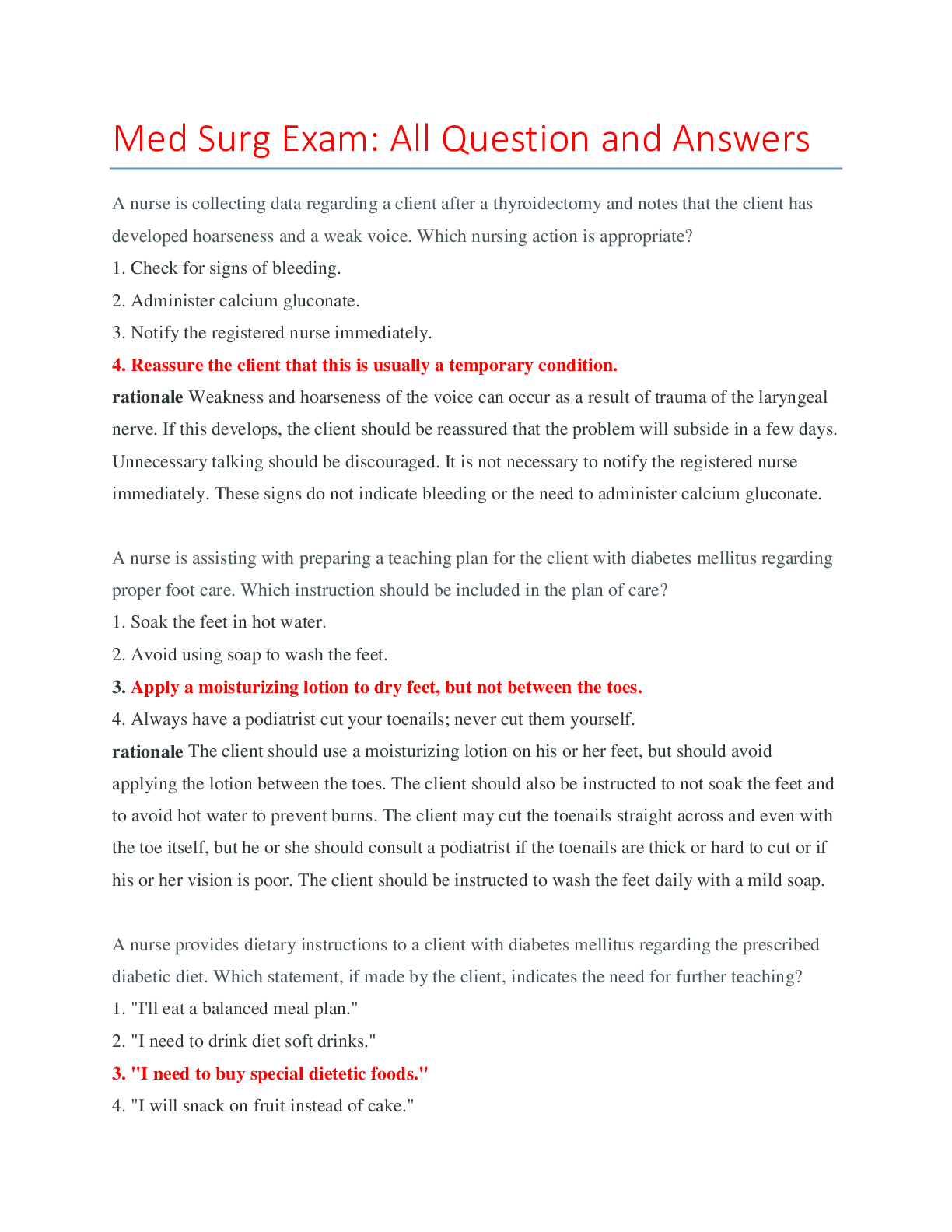
Reviews( 1 )

by Claudia · 3 years ago
Document information
Connected school, study & course
About the document
Uploaded On
Aug 06, 2020
Number of pages
54
Written in
Additional information
This document has been written for:
Uploaded
Aug 06, 2020
Downloads
2
Views
385

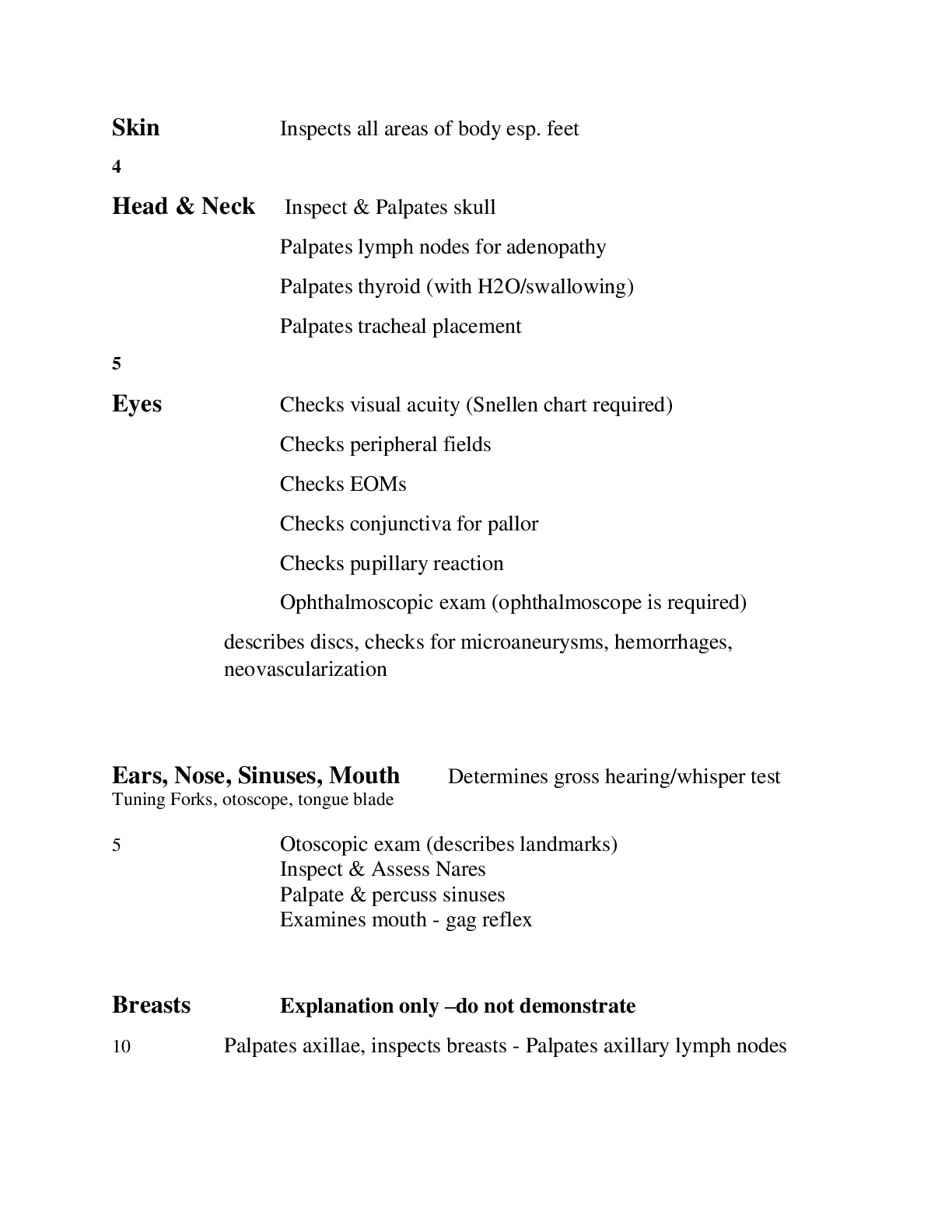


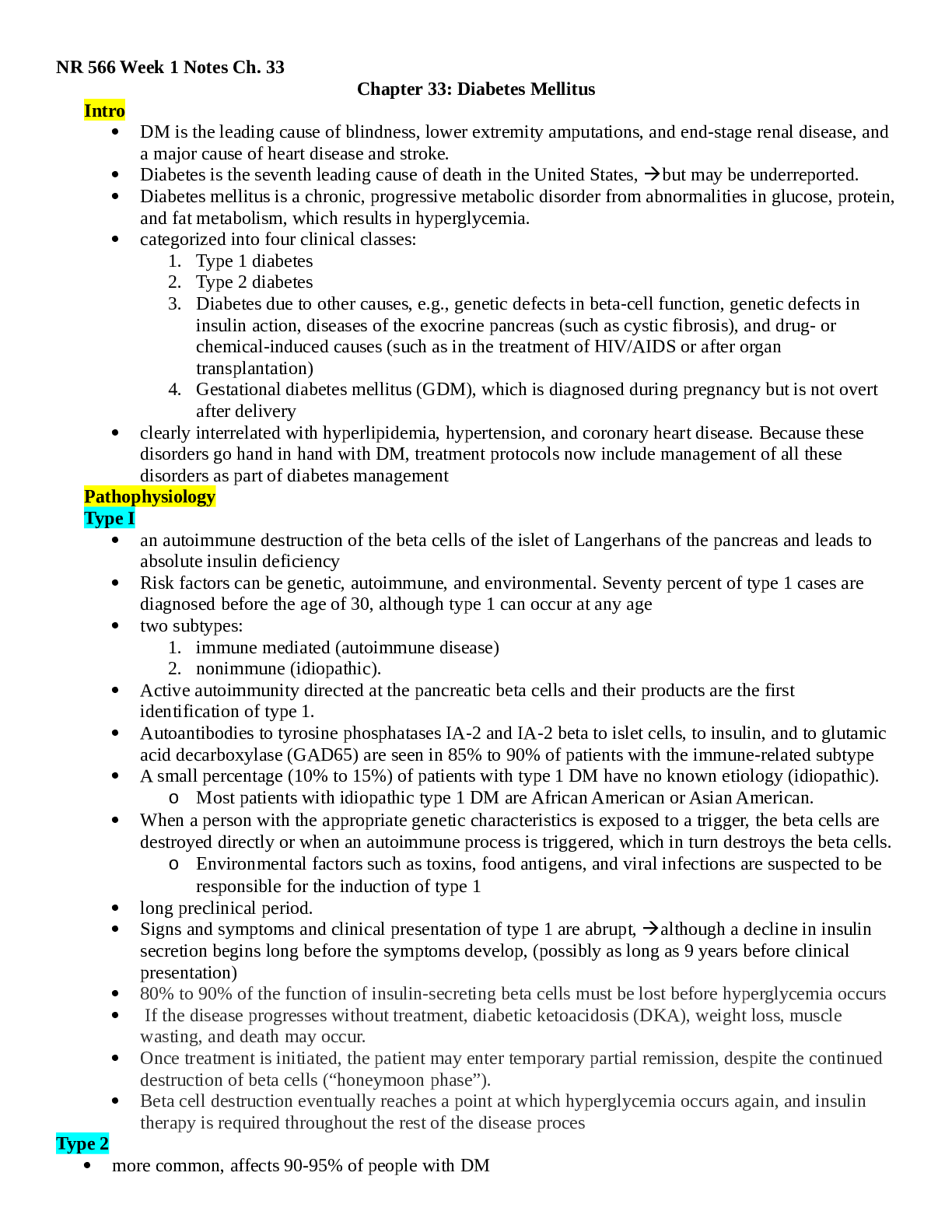
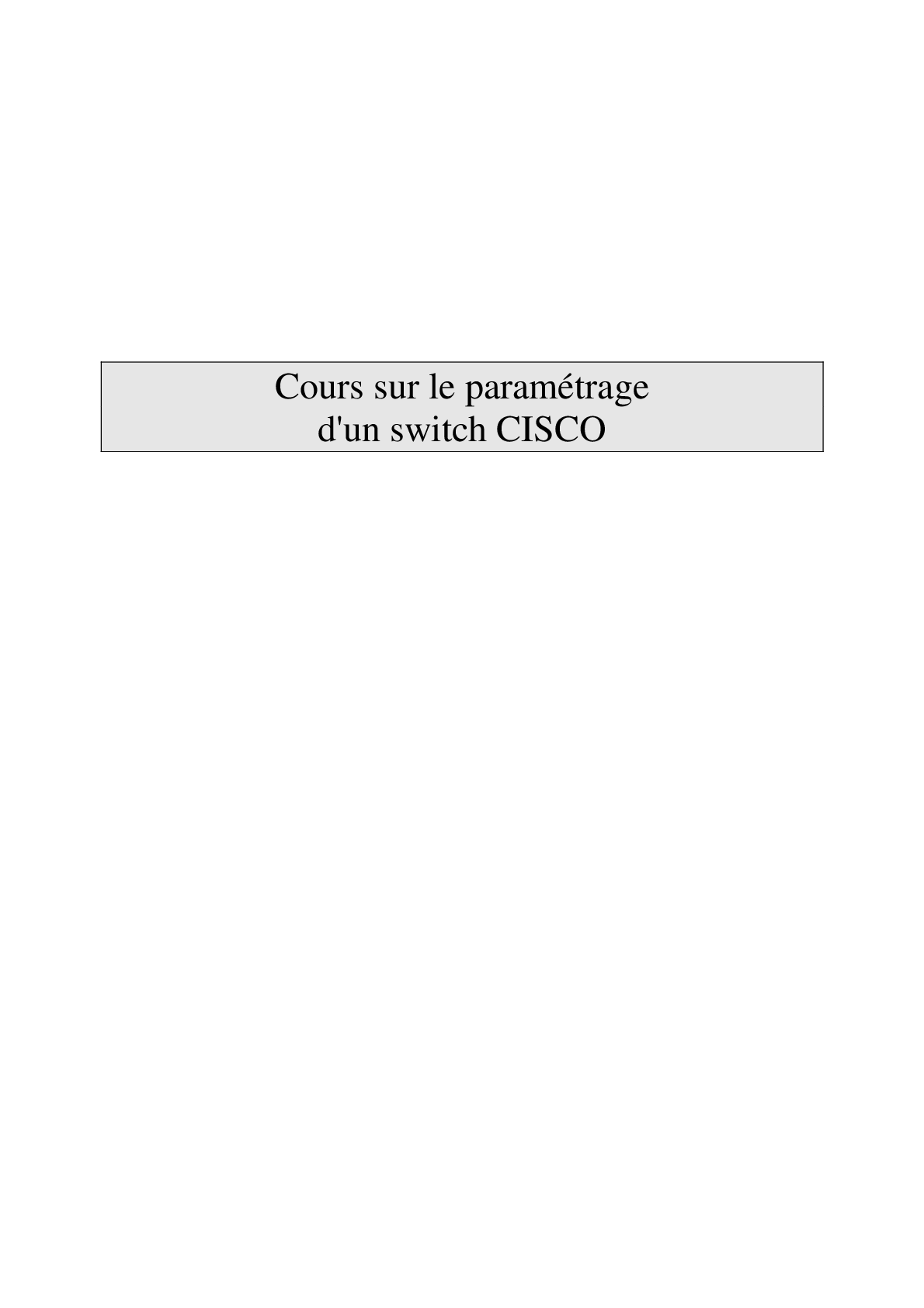
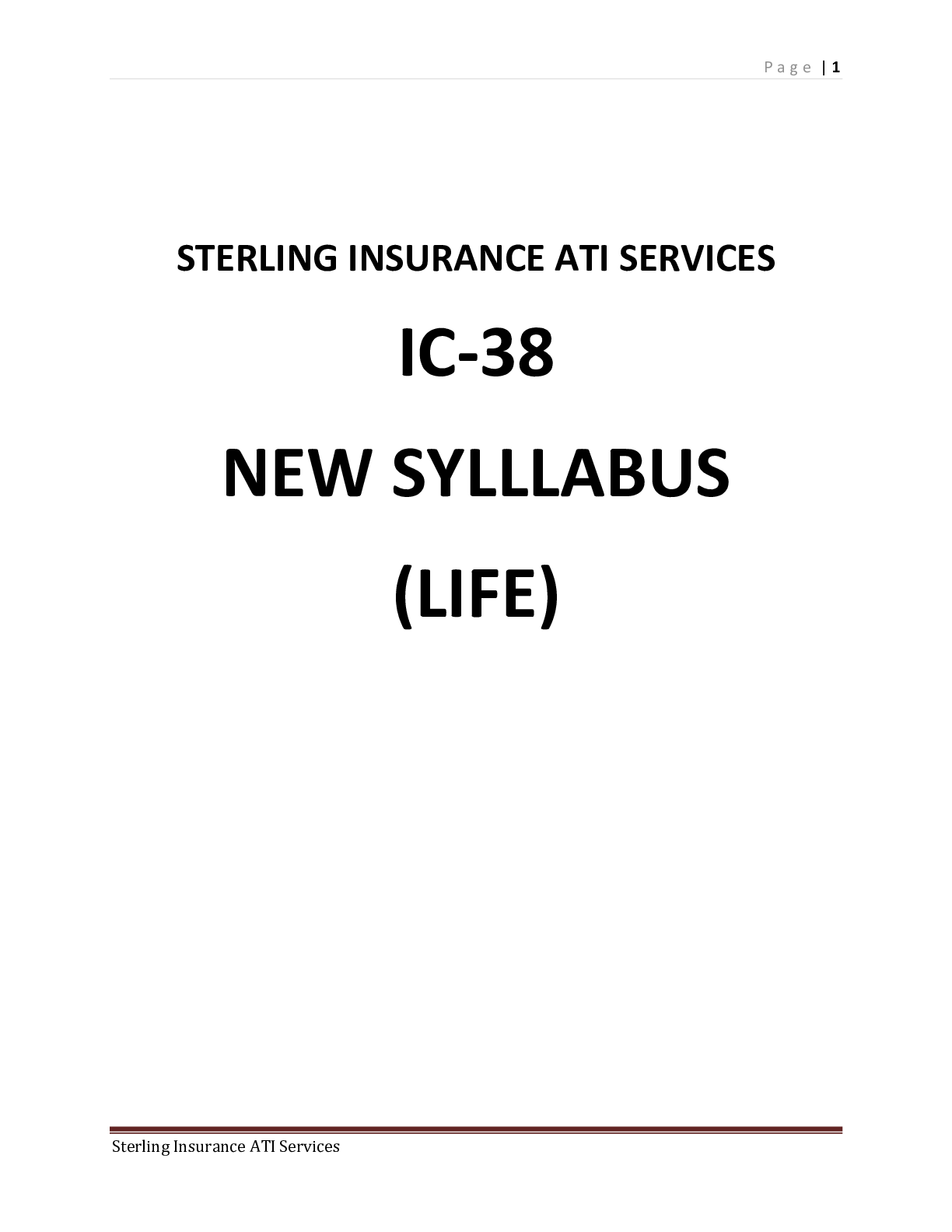
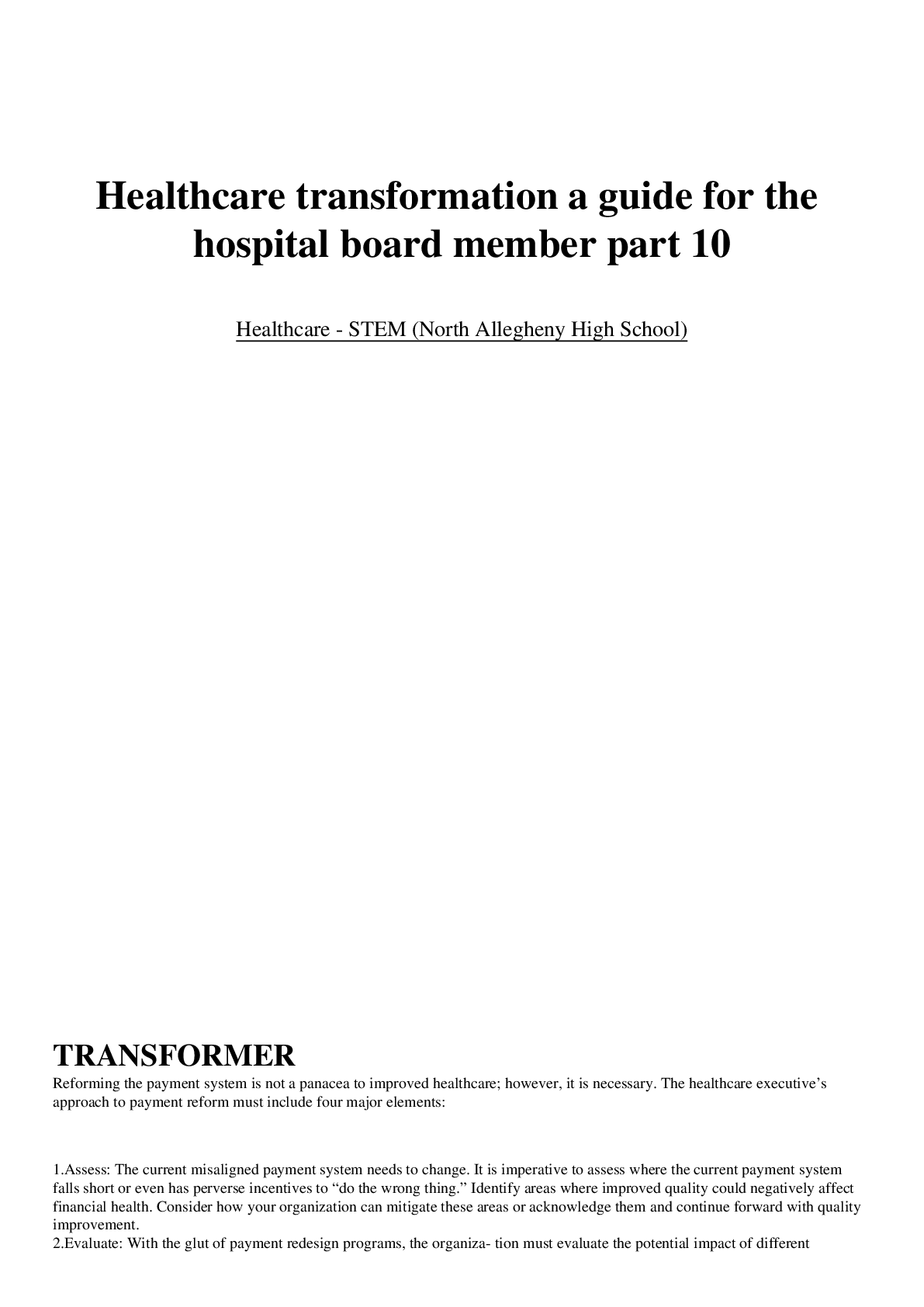

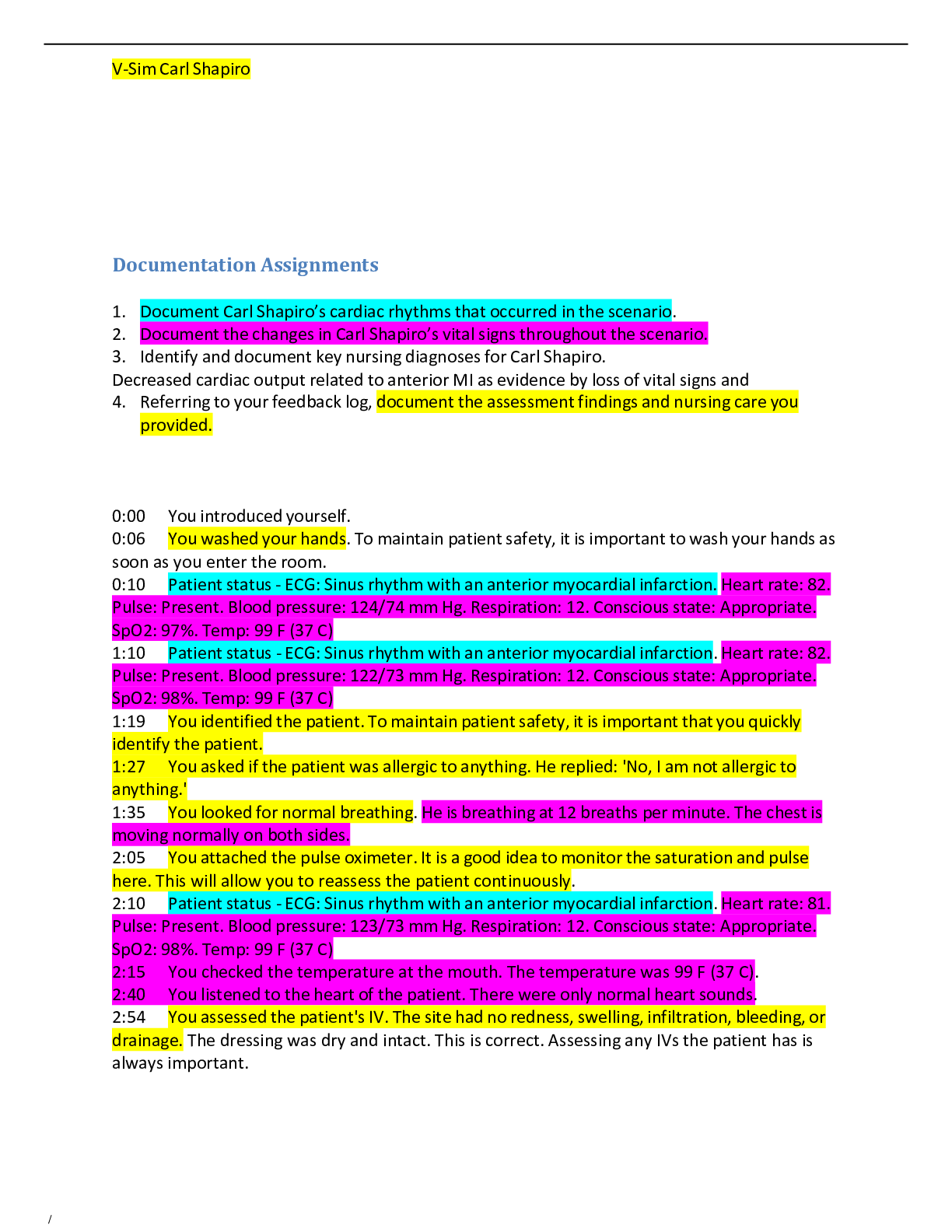
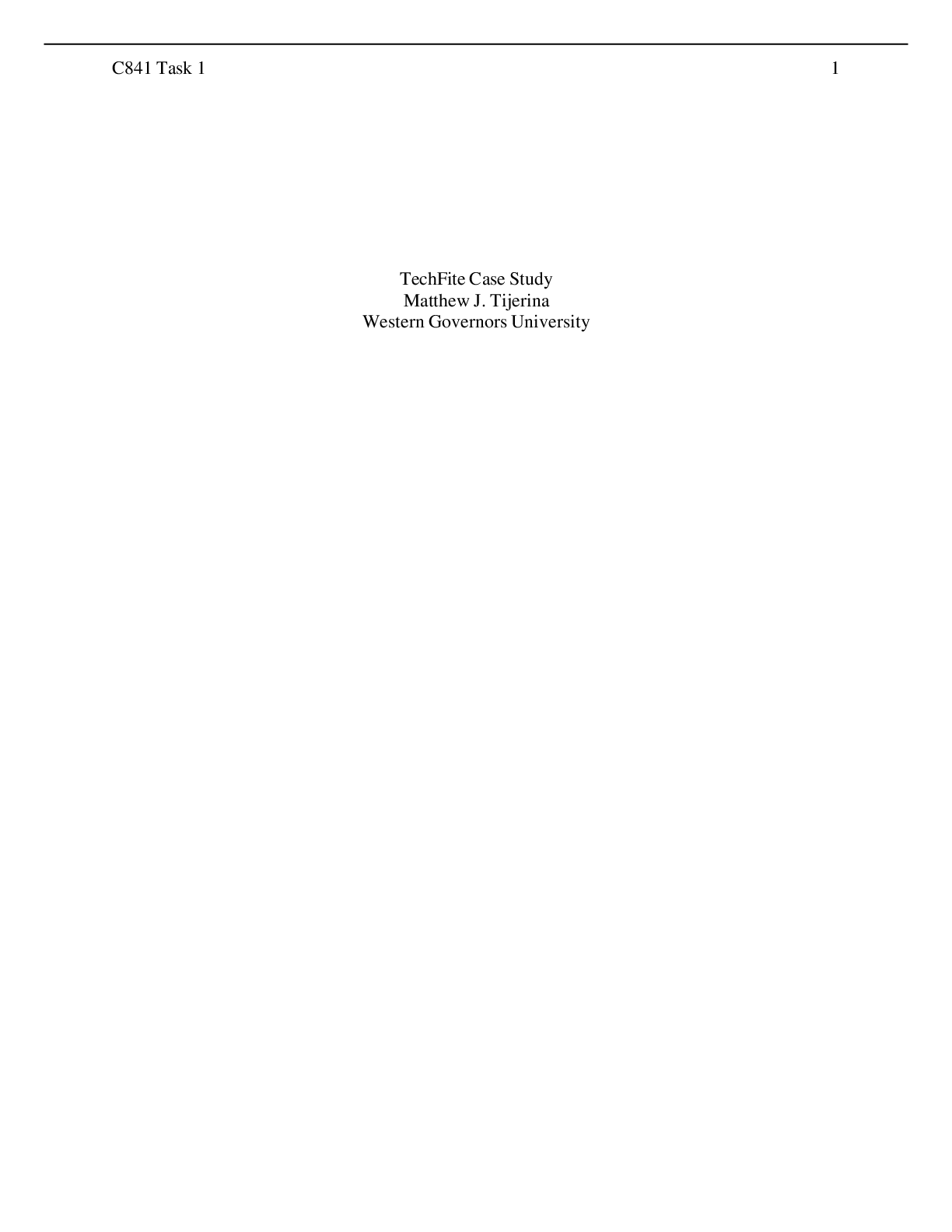
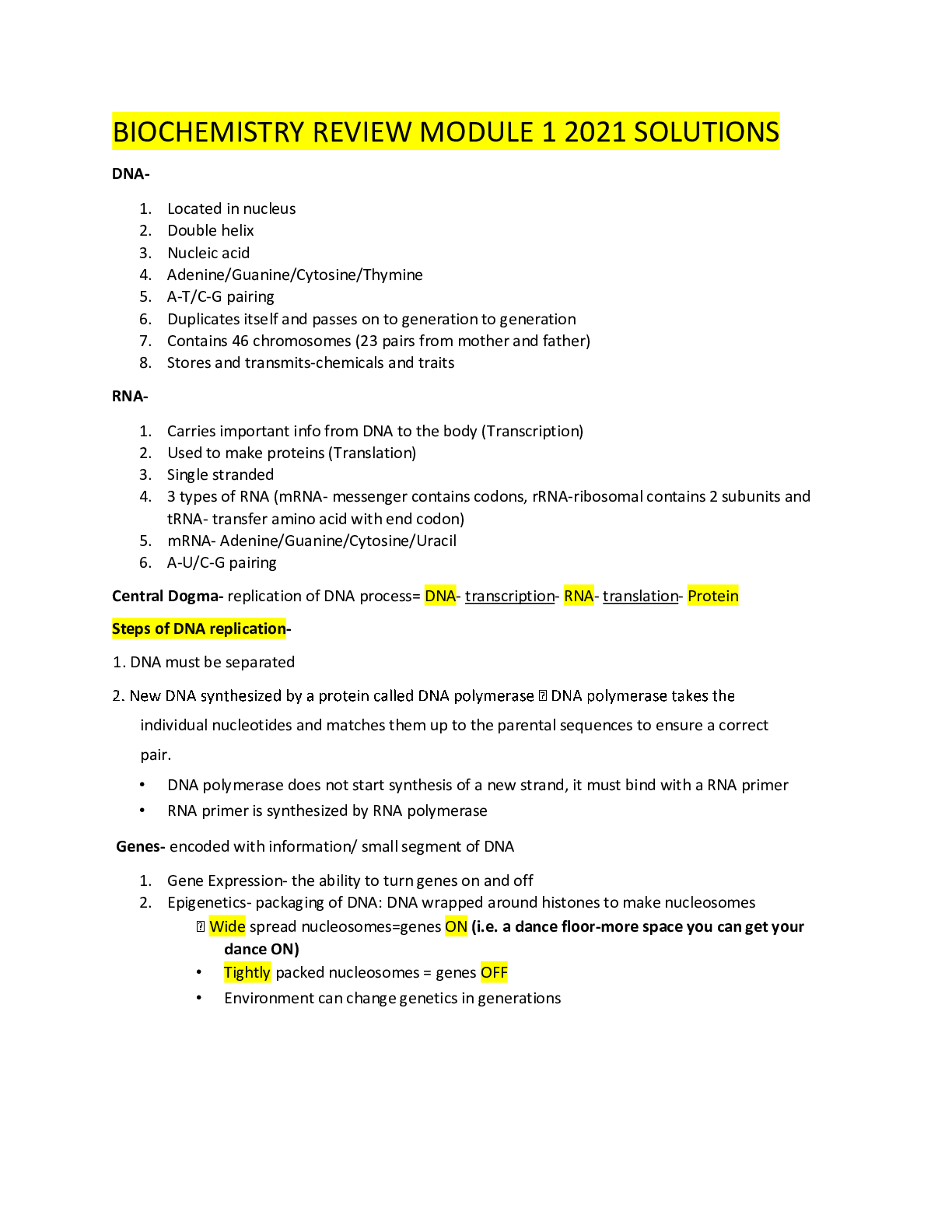
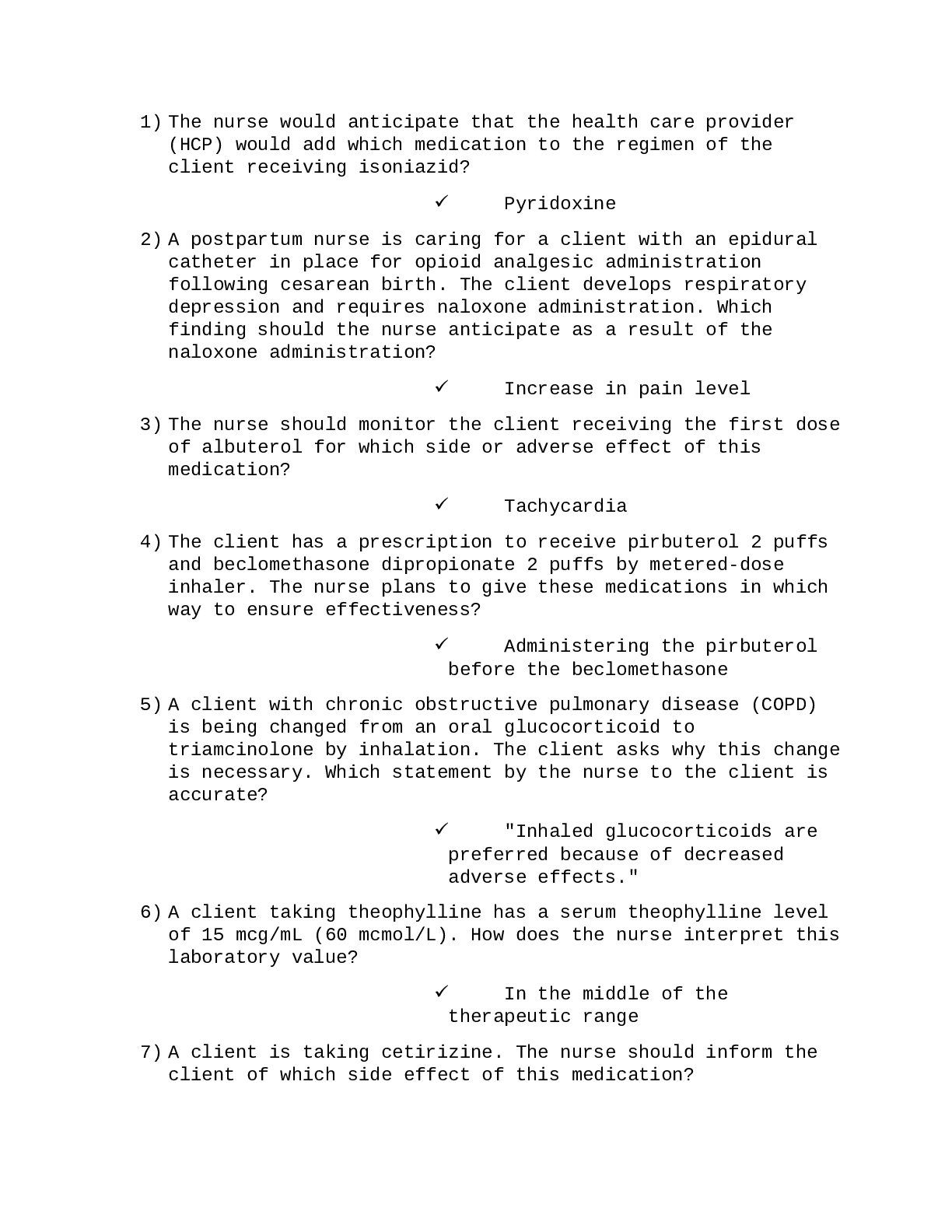
NSG110 AMERICANS RATE NURSES HIGHEST ON HONESTY, ETHICAL STANDARDS.png)
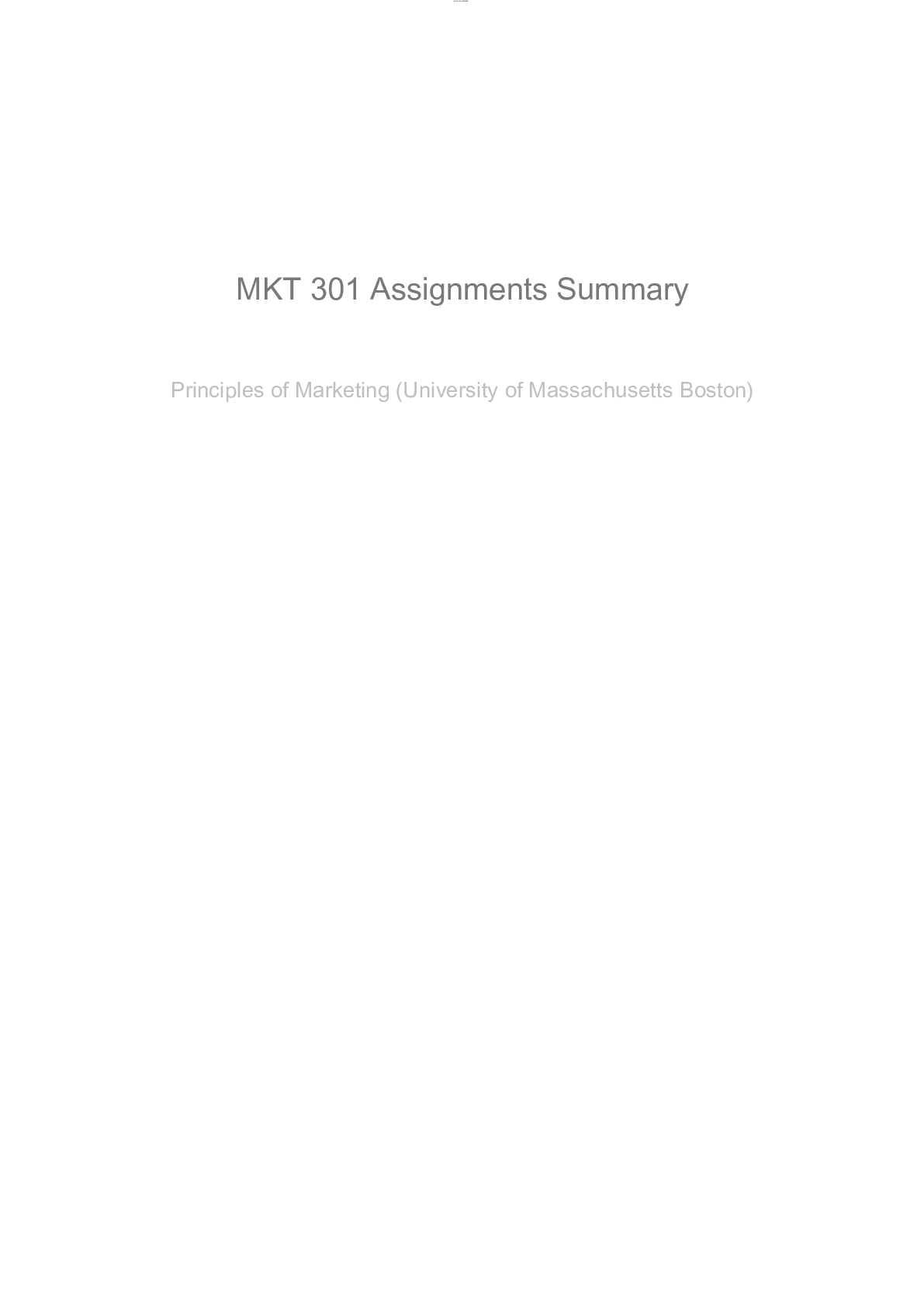
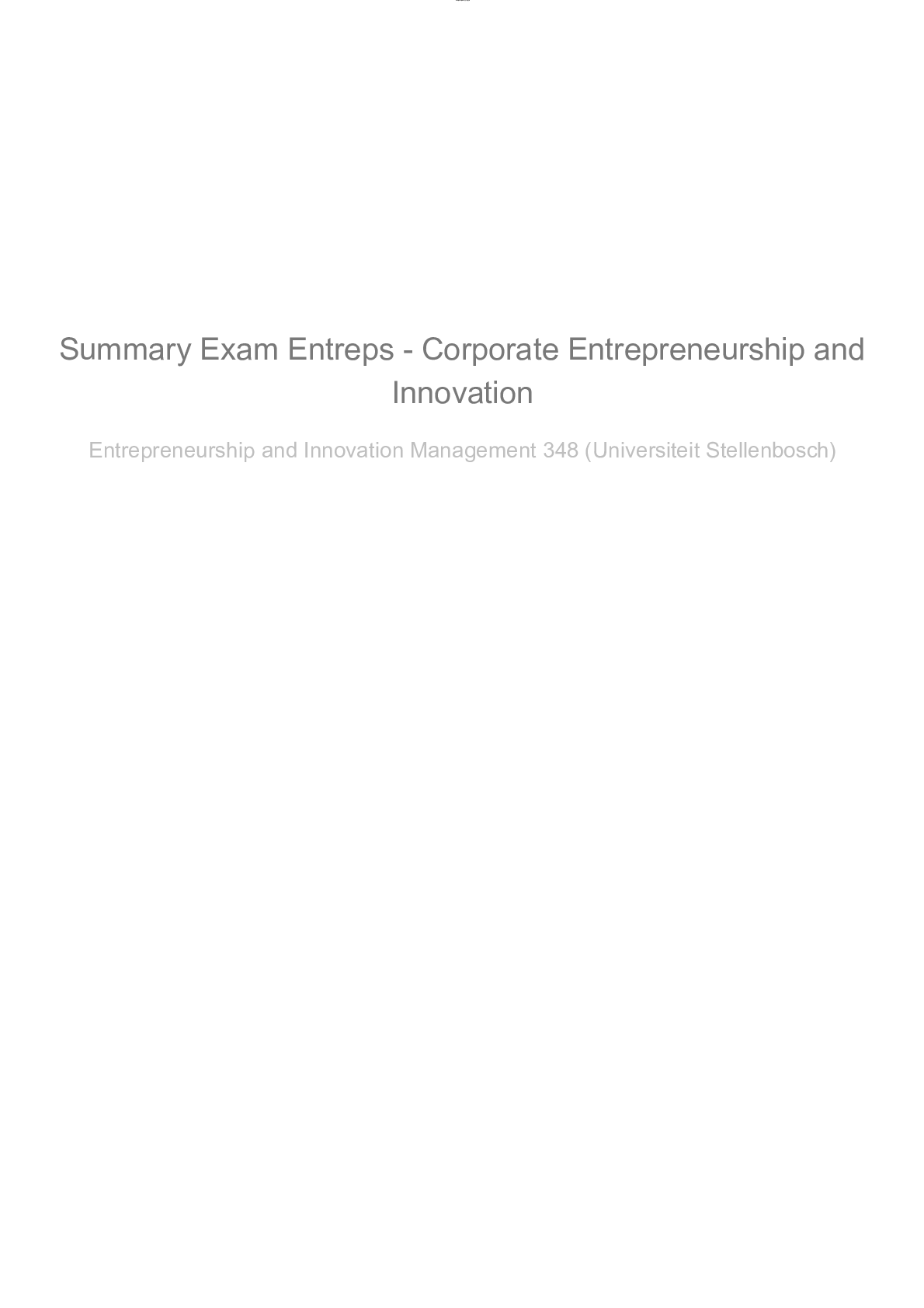

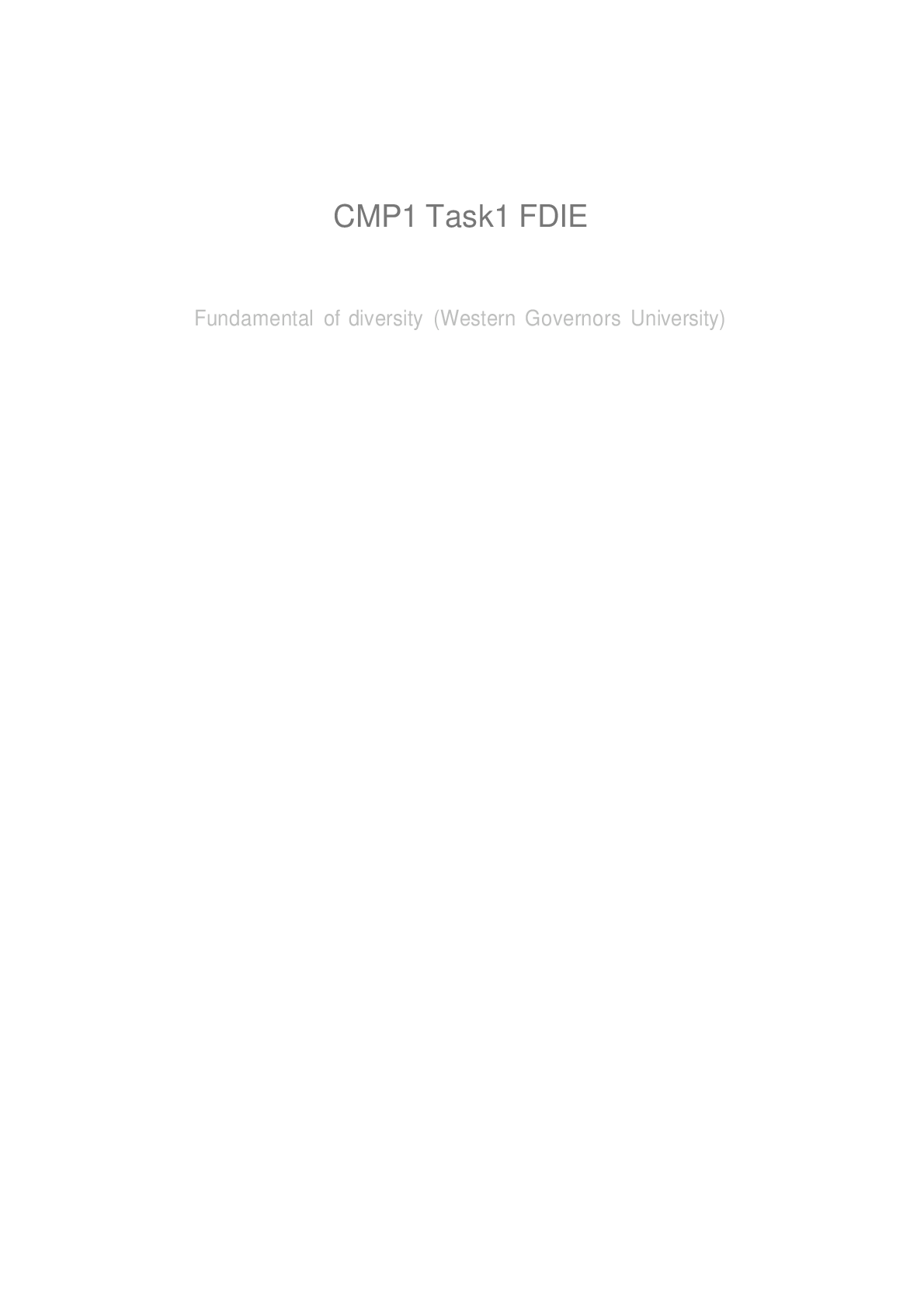
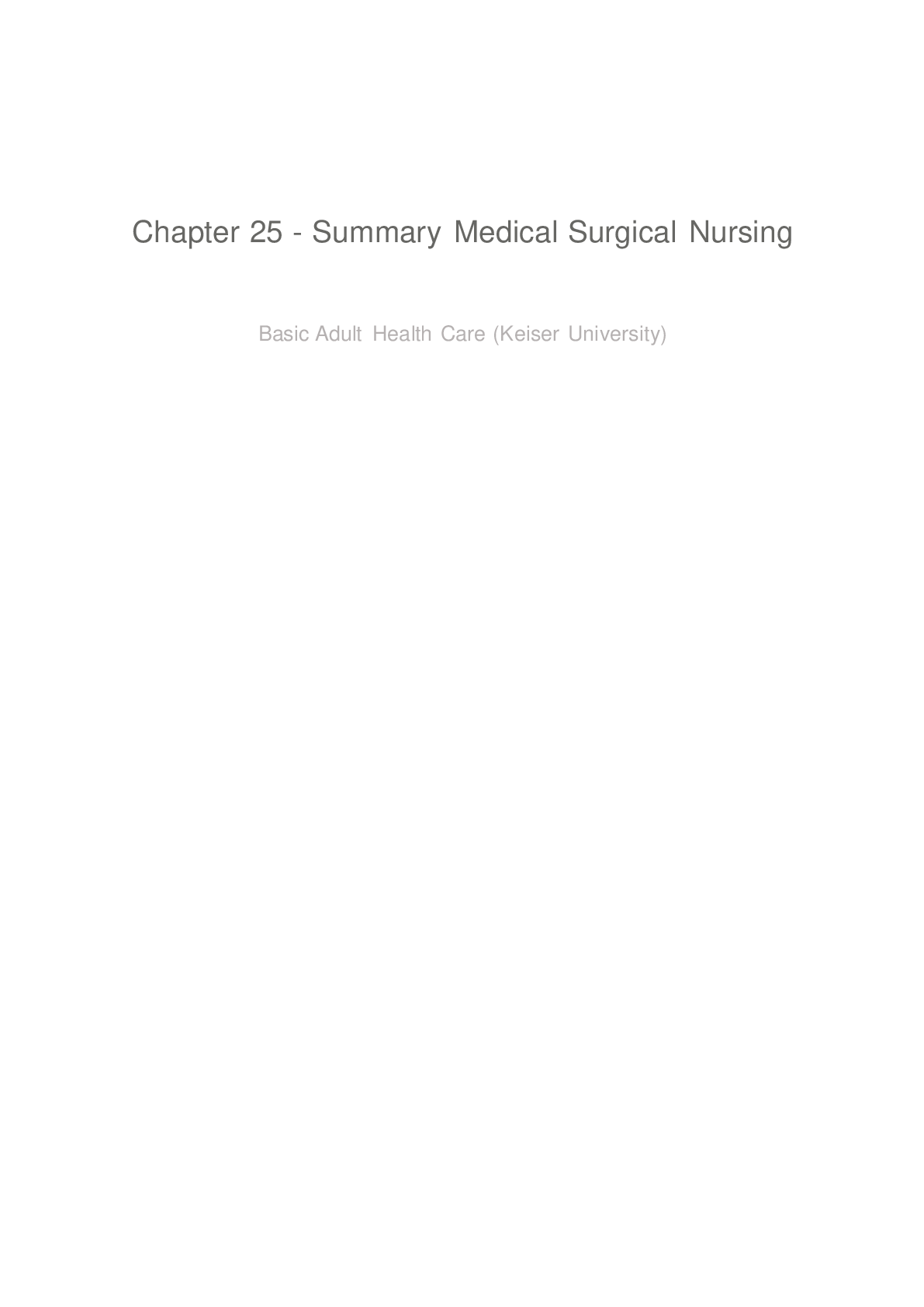
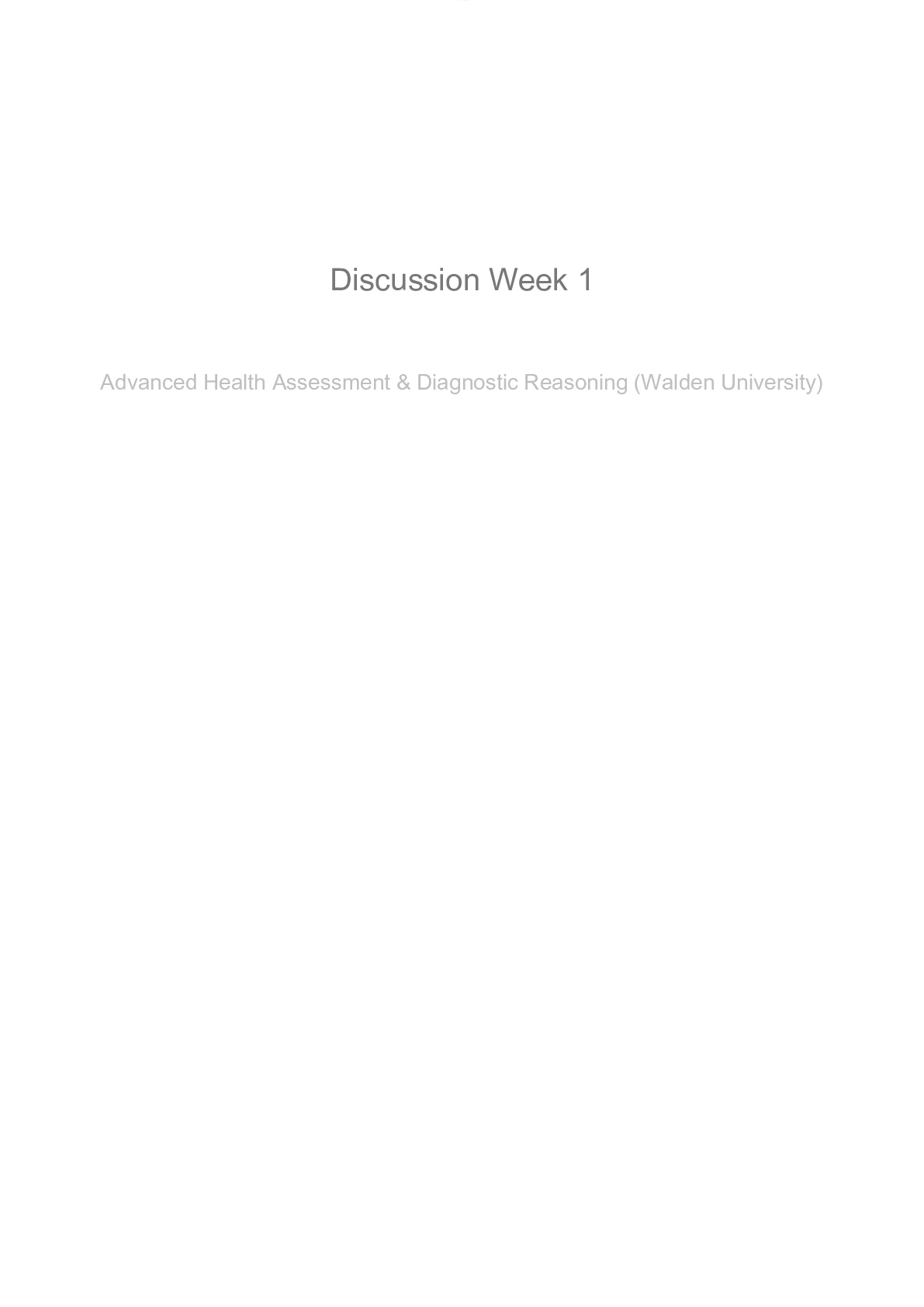
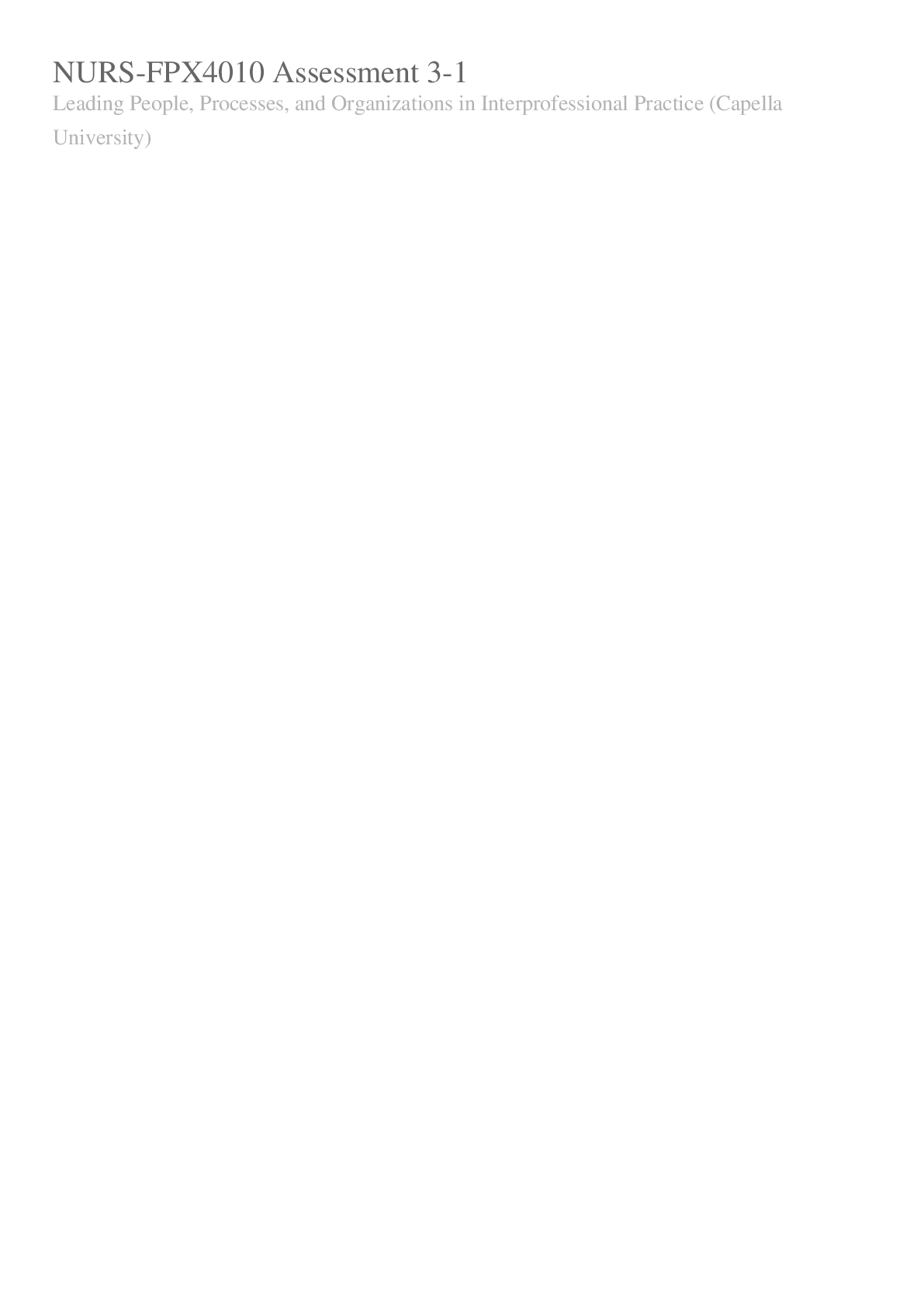
.png)


